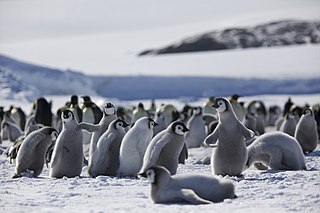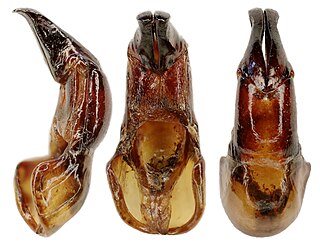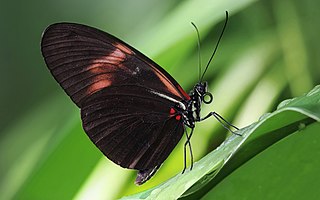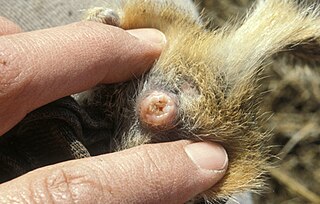
Insects in the family Tettigoniidae are commonly called katydids, or bush crickets. They have previously been known as "long-horned grasshoppers". More than 8,000 species are known. Part of the suborder Ensifera, the Tettigoniidae are the only extant (living) family in the superfamily Tettigonioidea.

Behavioral ecology, also spelled behavioural ecology, is the study of the evolutionary basis for animal behavior due to ecological pressures. Behavioral ecology emerged from ethology after Niko Tinbergen outlined four questions to address when studying animal behaviors: What are the proximate causes, ontogeny, survival value, and phylogeny of a behavior?

The green-veined white is a butterfly of the family Pieridae.

The speckled wood is a butterfly found in and on the borders of woodland areas throughout much of the Palearctic realm. The species is subdivided into multiple subspecies, including Pararge aegeria aegeria, Pararge aegeria tircis, Pararge aegeria oblita, and Pararge aegeria insula. The color of this butterfly varies between subspecies. The existence of these subspecies is due to variation in morphology down a gradient corresponding to a geographic cline. The background of the wings ranges from brown to orange, and the spots are either pale yellow, white, cream, or a tawny orange. The speckled wood feeds on a variety of grass species. The males of this species exhibit two types of mate locating behaviors: territorial defense and patrolling. The proportion of males exhibiting these two strategies changes based on ecological conditions. The monandrous female must choose which type of male can help her reproduce successfully. Her decision is heavily influenced by environmental conditions.

Internal fertilization is the union of an egg and sperm cell during sexual reproduction inside the female body. Internal fertilization, unlike its counterpart, external fertilization, brings more control to the female with reproduction. For internal fertilization to happen there needs to be a method for the male to introduce the sperm into the female's reproductive tract.

Heliconius charithonia, the zebra longwing or zebra heliconian, is a species of butterfly belonging to the subfamily Heliconiinae of the family Nymphalidae. It was first described by Carl Linnaeus in his 1767 12th edition of Systema Naturae. The boldly striped black and white wing pattern is aposematic, warning off predators.

An aedeagus is a reproductive organ of male arthropods through which they secrete sperm from the testes during copulation with a female. It can be thought of as the insect equivalent of a mammal's penis, though the comparison is fairly loose given the greater complexity of insect reproduction. The term is derived from Ancient Greek αἰδοῖα and ἀγός. It is pronounced or.

Mud-puddling, or simply puddling, is a behaviour most conspicuous in butterflies, but occurs in other animals as well, mainly insects; they seek out nutrients in certain moist substances such as rotting plant matter, mud and carrion and they suck up the fluid. Where the conditions are suitable, conspicuous insects such as butterflies commonly form aggregations on wet soil, dung or carrion. From the fluids they obtain salts and amino acids that play various roles in their physiology, ethology and ecology. This behaviour also has been seen in some other insects, notably the leafhoppers, e.g. the potato leafhopper, Empoasca fabae.

Heliconius melpomene, the postman butterfly, common postman or simply postman, is a brightly colored butterfly found throughout Central and South America. It was first described by Carl Linnaeus in his 1758 10th edition of Systema Naturae. Its coloration coevolved with a sister species H. erato as a warning to predators of its inedibility; this is an example of Müllerian mimicry. H. melpomene was one of the first butterfly species observed to forage for pollen, a behavior that is common in other groups but rare in butterflies. Because of the recent rapid evolutionary radiation of the genus Heliconius and overlapping of its habitat with other related species, H. melpomene has been the subject of extensive study on speciation and hybridization. These hybrids tend to have low fitness as they look different from the original species and no longer exhibit Müllerian mimicry.

Utetheisa ornatrix, also called the bella moth, ornate moth or rattlebox moth is a moth of the subfamily Arctiinae. It is aposematically colored ranging from pink, red, orange and yellow to white coloration with black markings arranged in varying patterns on its wings. It has a wingspan of 33–46 mm. Moths reside in temperate midwestern and eastern North America as well as throughout Mexico and other parts of Central America. Unlike most moths, the bella moth is diurnal. Formerly, the bella moth or beautiful utetheisa of temperate eastern North America was separated as Utetheisa bella. Now it is united with the bella moth in Utetheisa ornatrix.

A mating plug, also known as a copulation plug, sperm plug, vaginal plug, or sphragis, is gelatinous secretion used in the mating of some species. It is deposited by a male into a female genital tract, such as the vagina, and later hardens into a plug or glues the tract together. While females can expel the plugs afterwards, the male's sperm still gets a time advantage in getting to the egg, which is often the deciding factor in fertilization.

Edith's checkerspot is a species of butterfly in the family Nymphalidae. It is a resident species of western North America and among the subspecies, entomologists have long been intrigued by their many phenotypic variations in coloration, wing length, and overall body size. Most populations are monophagous and rely on plants including Plantago erecta and Orthocarpus densiflorus as its host species in developing from eggs through to larvae, pupae, and mature butterflies. Males exhibit polygyny whereas females rarely mate more than once. Males devote most of their attention to mate acquisition, and such mate locating strategies such as hilltopping behavior has developed. Climate change and habitat destruction has impacted certain subspecies. Two subspecies in particular, Euphydryas editha quino and Euphydryas editha bayensis, are currently under protection via the Endangered Species Act.
Pyrrolizidine alkaloid sequestration by insects is a strategy to facilitate defense and mating. Various species of insects have been known to use molecular compounds from plants for their own defense and even as their pheromones or precursors to their pheromones. A few Lepidoptera have been found to sequester chemicals from plants which they retain throughout their life and some members of Erebidae are examples of this phenomenon. Starting in the mid-twentieth century researchers investigated various members of Arctiidae, and how these insects sequester pyrrolizidine alkaloids (PAs) during their life stages, and use these chemicals as adults for pheromones or pheromone precursors. PAs are also used by members of the Arctiidae for defense against predators throughout the life of the insect.
Cytoplasmic incompatibility (CI) is a phenomenon that results in sperm and eggs being unable to form viable offspring. The effect arises from changes in the gamete cells caused by intracellular parasites like Wolbachia, which infect a wide range of insect species. As the reproductive incompatibility is caused by bacteria that reside in the cytoplasm of the host cells, it is referred to as cytoplasmic incompatibility. In 1971, Janice Yen and A. Ralph Barr of UCLA demonstrated the etiologic relationship of Wolbachia infection and cytoplasmic incompatibility in Culex mosquitos when they found that eggs were killed when the sperm of Wolbachia-infected males fertilized infection-free eggs.
Ostrinia scapulalis, the adzuki bean borer or adzuki bean worm, is a species of moth in the family Crambidae. It was described by Francis Walker in 1859. It is one of 20 moths in the genus Ostrinia and is of Eurasian origin. The larvae have a gray mid-dorsal line and can be light pink or beige. The adult adzuki bean borer has a yellowish-brown forewing with jagged lines and variable darker shading, with a wingspan that ranges from 20 to 32 mm. The moths of this species are nocturnal and tend to be attracted to light.
A nuptial gift is a nutritional gift given by one partner in some animals' sexual reproduction practices.

Sexual selection in amphibians involves sexual selection processes in amphibians, including frogs, salamanders and newts. Prolonged breeders, the majority of frog species, have breeding seasons at regular intervals where male-male competition occurs with males arriving at the waters edge first in large number and producing a wide range of vocalizations, with variations in depth of calls the speed of calls and other complex behaviours to attract mates. The fittest males will have the deepest croaks and the best territories, with females making their mate choices at least partly based on the males depth of croaking. This has led to sexual dimorphism, with females being larger than males in 90% of species, males in 10% and males fighting for groups of females.

Jerrold Meinwald was an American chemist known for his work on chemical ecology, a field he co-founded with his colleague and friend Thomas Eisner. He was a Goldwin Smith Professor Emeritus of Chemistry at Cornell University. He was author or co-author of well over 400 scientific articles. His interest in chemistry was sparked by fireworks done with his friend Michael Cava when they were still in junior high school. Meinwald was also a music aficionado and studied flute with Marcel Moyse – the world's greatest flutist of his time.

Hydroxydanaidal is an insect pheromone synthesized by some species of moth from pyrrolizidine alkaloids found in their diet.

Hemiandrus maculifrons is a species of ground wētā endemic to New Zealand. They are nocturnal, carnivorous, and flightless orthopterans belonging to the family Anostostomatidae. Being a nocturnal species, individuals remain in tunnels in the ground during the day and emerge from their burrows after sunset to forage and hunt for small invertebrates. H. maculifrons is one of the smallest New Zealand weta species, averaging 15 mm in length and weighing 1–3 g. Unlike the tree weta and tusked weta, where sexual dimorphism is found in the form of male weaponry, ground weta only exhibit sexual size dimorphism: the females are larger than the males.















